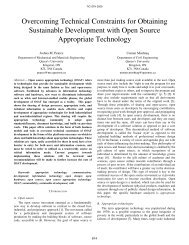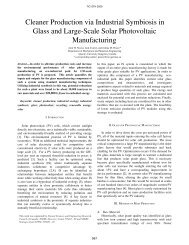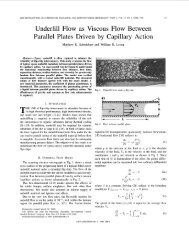Optimizing greenhouse gas mitigation strategies to suppress energy
Optimizing greenhouse gas mitigation strategies to suppress energy
Optimizing greenhouse gas mitigation strategies to suppress energy
Create successful ePaper yourself
Turn your PDF publications into a flip-book with our unique Google optimized e-Paper software.
2nd Climate Change Technology Conference<br />
2ième Conférence sur les technologies du changement climatique<br />
May 12-15 mai 2009, Hamil<strong>to</strong>n, Ontario, Canada<br />
global scale as each passing year makes the problem of replacing fossil fuels before reaching<br />
the 450ppm absolute limit of CO 2 concentration that much more challenging.<br />
4. Complications in quantifying the effects of <strong>energy</strong> cannibalism<br />
The cannibalization effect, however, is more complicated than the simple yet vast results<br />
above would indicate. There are both positive and negative effects.<br />
First, with each ET plant constructed, the embodied GHG emissions of the next plant will be<br />
reduced because the fraction of non-fossil fuel based <strong>energy</strong> has increased. As the embodied<br />
GHG emissions is decreased and the effective growth rate can be increased. It is also likely<br />
that sources of <strong>energy</strong> that have lower mass CO 2 -eq. per unit <strong>energy</strong> rates than fossil fuels<br />
will be deployed at an expanding rate as economies of scale drive down cost as production<br />
increases (e.g. solar pho<strong>to</strong>voltaic cells) [16]. This will speed the decrease in the embodied<br />
GHG emissions for any type of ET ensemble. Similarly for each ET device deployed that<br />
conserves <strong>energy</strong> the <strong>to</strong>tal amount of <strong>energy</strong> needed is reduced, which reduces the necessary r<br />
<strong>to</strong> meet a climate neutral <strong>energy</strong> state at a specific point in time. In addition, as the <strong>to</strong>tal<br />
demand is reduced the least efficient conventional plants are taken off line. This further<br />
decreases the embodied <strong>energy</strong> of future ETs. Thus the growth rate needed for stabilization of<br />
the earth's climate can be decreased with a suitable deployment of ETs.<br />
Second, as we deplete the dwindling supplies of fossil fuels the embodied <strong>energy</strong> and<br />
emissions <strong>to</strong> extract and use these sources increases. We must drill deeper, uncover more<br />
earth, and explore increasingly less hospitable terri<strong>to</strong>ries <strong>to</strong> capture declining supplies of both<br />
fuels used <strong>to</strong> form ETs and materials used <strong>to</strong> make ETs. For example, Cleveland and<br />
Costanza studied the <strong>energy</strong> return on <strong>energy</strong> invested (EROI) of natural <strong>gas</strong> production in<br />
Louisiana through early production, peak, and in<strong>to</strong> decline [17]. They found that the EROI<br />
decline rate of a resource as it is dwindling is both linear and remarkably steep. The EROI<br />
plunged from maximum <strong>to</strong> minimum in only the last 25% of the <strong>energy</strong> extracted [17]. As the<br />
EROI decreases for fossil fuel <strong>energy</strong> used <strong>to</strong> supply ETs, the <strong>energy</strong> payback time of the ETs<br />
increase, and the embodied <strong>energy</strong> and emissions both increase. This is also the case if<br />
nuclear <strong>energy</strong> is used <strong>to</strong> provide the embodied <strong>energy</strong> of ETs because as more nuclear<br />
<strong>energy</strong> is utilized the high grade ores are depleted and less concentrated ore, which demands<br />
greater embodied <strong>energy</strong> <strong>to</strong> process is required [12]. The further we deplete the given<br />
resource the worse the effect. Thus the limit of the growth rate of ETs needed for stabilization<br />
of the earth's climate would be decreased. In an age where the production of the supplies of<br />
particular fossil fuels are reaching their peak in an ever growing list of regions and the global<br />
peak in oil extraction appears near, this concept becomes increasingly relevant <strong>to</strong> <strong>energy</strong><br />
payback calculations. Full vetting of this concept along with the beneficial effect discussed<br />
previously, will need <strong>to</strong> be completed in the future as all ET candidates are identified and full<br />
LCAs are completed for each geographical location.<br />
5. Necessary renewable <strong>energy</strong> rates of expansion<br />
5.1 Replacing existing fossil fuel <strong>energy</strong> infrastructure<br />
Page 5 of 9








